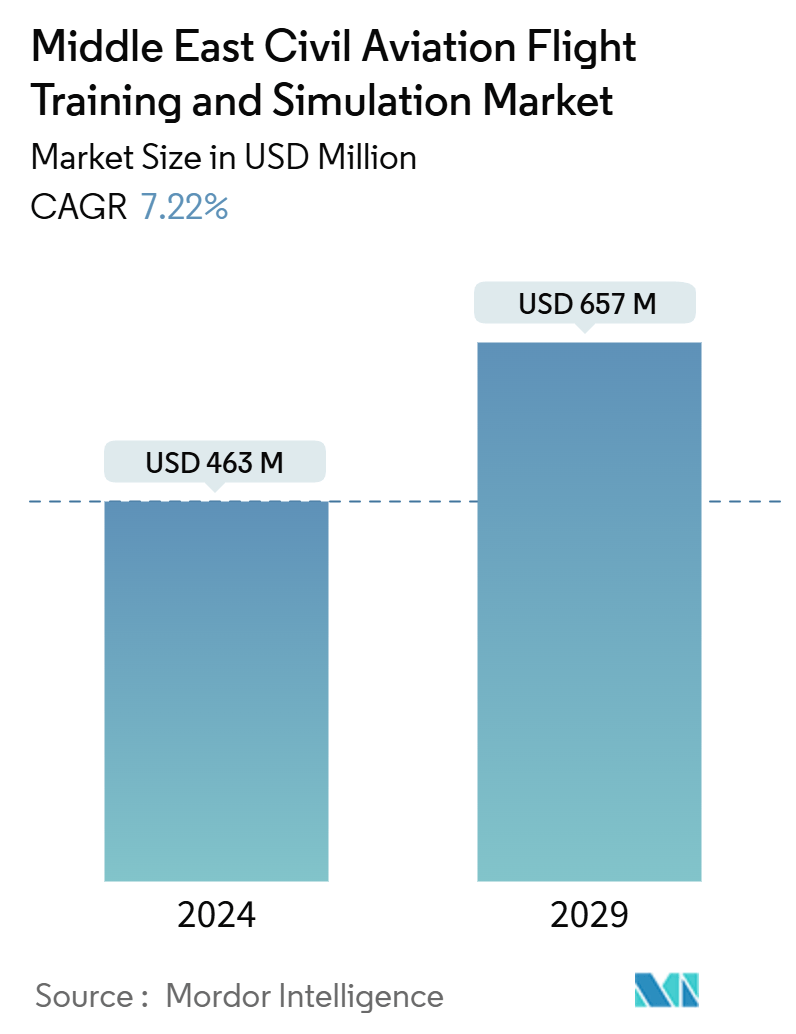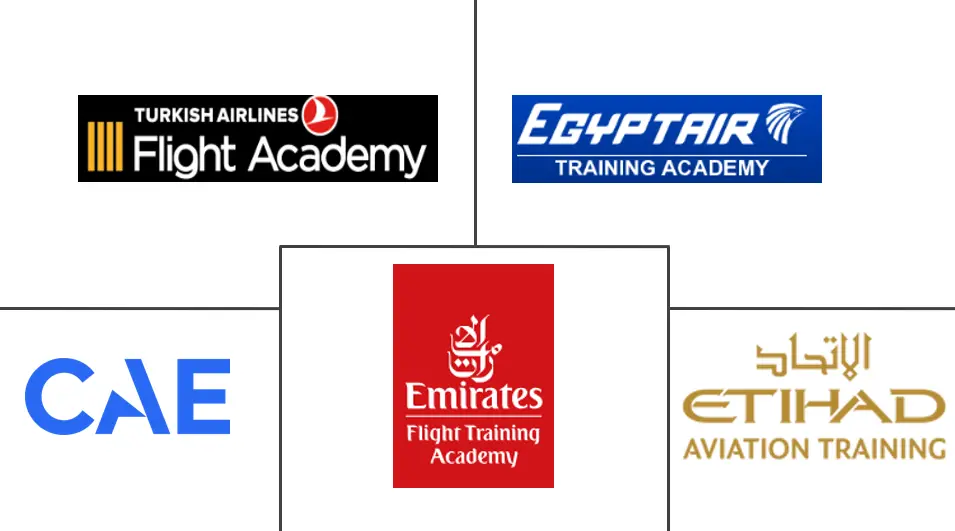Market Size of Middle East Civil Aviation Flight Training And Simulation Industry

| Study Period | 2019 - 2029 |
| Base Year For Estimation | 2023 |
| Market Size (2024) | USD 463 Million |
| Market Size (2029) | USD 657 Million |
| CAGR (2024 - 2029) | 7.22 % |
| Market Concentration | Low |
Major Players
*Disclaimer: Major Players sorted in no particular order |
Middle East Civil Aviation Flight Training & Simulation Market Analysis
The Middle East Civil Aviation Flight Training And Simulation Market size is estimated at USD 463 million in 2024, and is expected to reach USD 657 million by 2029, at a CAGR of 7.22% during the forecast period (2024-2029).
Flight simulators are pivotal in pilot training, providing a realistic environment to refine flying skills. They accurately replicate real-world scenarios, encompassing diverse weather conditions and emergencies. With the Middle East witnessing a surge in air traffic and a heightened demand for skilled pilots, the need for aviation simulators in the region is on the rise. Airlines and flight training academies are increasingly adopting simulators due to their efficiency, cost-effectiveness, and crucial role in pilot safety.
Furthermore, the region's increasing passenger traffic is leading to a rise in the procurement of next-generation aircraft. The substantial order books of industry giants such as Boeing and Airbus further emphasize this trend. As airlines expand their fleets, the demand for pilots with commercial certifications escalates, further highlighting the importance of advanced flight simulators.
Currently, the Middle East faces a shortage of local pilots, prompting regional airlines to focus on developing domestic talent. This approach helps airlines reduce costs associated with hiring foreign pilots and aligns with the government's aim of creating local job opportunities. These proactive steps by airlines are set to boost the demand for pilot training in the coming years.
Middle East Civil Aviation Flight Training & Simulation Industry Segmentation
The civil aviation flight training and simulation market focuses on training pilots for civil aviation aircraft. The study highlights flight simulators, which replicate pilot training environments. It covers pilot training for commercial aviation, specifically for fixed-wing aircraft, excluding rotorcraft. The market estimates are centered on the service segment of the commercial aviation industry, encompassing revenues from simulator training (both type rating and recurrent) and ground and flight school training. Military training revenues are not factored into these estimates.
The market is segmented on training type and geography. By training type, the market is segmented into flight school/ground school and simulation training. The simulation type is further segmented into full flight simulator (FFS), fixed training devices (FTD), and other simulator types ( Advanced Aviation Training Devices (AATD) / Basic Aviation Training Devices (BATD). The report also offers the market size and forecasts for six countries across the region. For each segment, the market sizing and forecasts have been done based on value (USD).
| By Training Type | |||||
| Flight School/Ground School | |||||
|
| By Geography | |
| United Arab Emirates | |
| Saudi Arabia | |
| Qatar | |
| Bahrain | |
| Oman | |
| Kuwait | |
| Rest of Middle East |
Middle East Civil Aviation Flight Training And Simulation Market Size Summary
The Middle East civil aviation flight training and simulation market is poised for significant growth, driven by the recovery of the aviation industry post-COVID-19 and the increasing demand for pilots. Major airlines in the region, such as Emirates and Etihad Airways, are focusing on developing local talent to reduce reliance on foreign pilots, which is expected to boost the demand for pilot training. The simulator training segment is particularly prominent, as it allows for comprehensive training scenarios that enhance pilot preparedness without the risks associated with real-flight training. This has led to increased investments in advanced simulators by pilot training schools, further propelling market growth.
The United Arab Emirates currently leads the market, supported by the high demand for pilots from its major airlines and the planned expansion of their fleets. Regional pilot training schools are expanding their training capacities to meet this demand, with significant investments in new training equipment and partnerships with airlines. The market is characterized by a fragmented landscape with numerous local training schools, and key players are enhancing their market share through strategic procurements and collaborations. These developments are expected to sustain the market's growth trajectory in the coming years, as the region continues to recover and expand its aviation operations.
Middle East Civil Aviation Flight Training And Simulation Market Size - Table of Contents
-
1. MARKET DYNAMICS
-
1.1 Market Overview
-
1.2 Market Drivers
-
1.3 Market Restraints
-
1.4 Industry Attractiveness - Porter's Five Forces Analysis
-
1.4.1 Bargaining Power of Suppliers
-
1.4.2 Bargaining Power of Buyers/Consumers
-
1.4.3 Threat of New Entrants
-
1.4.4 Threat of Substitute Products
-
1.4.5 Intensity of Competitive Rivalry
-
-
-
2. MARKET SEGMENTATION
-
2.1 By Training Type
-
2.1.1 Flight School/Ground School
-
2.1.2 Simulation Training
-
2.1.2.1 Full Flight Simulator (FFS)
-
2.1.2.2 Fixed Training Devices (FTD)
-
2.1.2.3 Other Simulator Types
-
-
-
2.2 By Geography
-
2.2.1 United Arab Emirates
-
2.2.2 Saudi Arabia
-
2.2.3 Qatar
-
2.2.4 Bahrain
-
2.2.5 Oman
-
2.2.6 Kuwait
-
2.2.7 Rest of Middle East
-
-
Middle East Civil Aviation Flight Training And Simulation Market Size FAQs
How big is the Middle East Civil Aviation Flight Training And Simulation Market?
The Middle East Civil Aviation Flight Training And Simulation Market size is expected to reach USD 463 million in 2024 and grow at a CAGR of 7.22% to reach USD 657 million by 2029.
What is the current Middle East Civil Aviation Flight Training And Simulation Market size?
In 2024, the Middle East Civil Aviation Flight Training And Simulation Market size is expected to reach USD 463 million.

